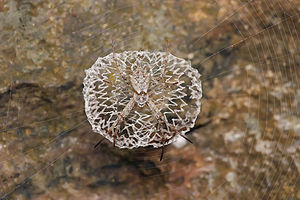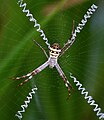Stabilimentum


spiders both same genus
on the stabilimentum at the center of the web.
Astabilimentum(plural:stabilimenta), also known as aweb decoration,is a conspicuoussilkstructure included in the webs of some species oforb-webspider.Its function is a subject of debate.
Origin[edit]
Likely, the use of stabilimenta evolved independently at least nine different times. AraneusandGasteracanthamake silk stabilimenta, whileCyclosaand the closely relatedAllocyclosa bifurcamake stabilimenta of silk, detritus, and their egg sacs. All those evolved independently from those ofArgiope,although some decorations ofAllocyclosa bifurcaclosely resemble those ofArgiope.[1]
Form[edit]
Although web decorations are common in several spider species in the familiesAraneidae,Tetragnathidae,andUloboridae,they are probably best known from spiders of the genusArgiope.This genus includes several species known as theSaint Andrew's Cross spiders,so named for their habit of resting in their webs with their legs outstretched in the shape of an X, the traditional shape of thecross of Saint Andrew.Argiope argentata,more commonly known as silver argiopes, are also known for spinning stabilimenta into their web. These stabilimenta can appear as zig-zag lines, and most commonly come in bouts of four creating a center-less X.[2]Spiders in this genus also construct web decorations as vertical lines, and juveniles commonly construct disc-shaped decorations.[3]Other spiders construct round structures covering the entire hub of the web.Azilia vachoniconstruct conspicuous stabilimenta with attached detritus such as egg sacs and insect carcasses (mostly their prey), and also hang debris such as dried leaves from their webs.[4]
-
The detail of the stabilimentum in the web of a femaleArgiope lobatashowing its zig-zag structure and rostral location
-
Argiope aethereafrom Australia build X-shaped decorations
-
AnOctonoba yaeyamensiswith a spiral stabilimentum
-
Oval spiralCyclosa sp.,India
-
Argiope sp.
Function[edit]
There is much controversy surrounding the function of these structures, and different species likely use them for different purposes.
Originally the decorations were thought to stabilize the web (hence the termstabilimentum),[5]though this hypothesis has since been dismissed because it was found that the decoration is only loosely attached to the web so that the actual influence on the stability could only be minor.[6]
Notable is the fact that stabilimentum-building spiders are largelydiurnal.[7]It has been suggested that stabilimenta could protect the spider by either camouflaging it (by breaking up its outline) or making it appear larger (by extending its outline).[8]Another hypothesis is that they make the web visible and therefore animals such as birds are less likely to damage the spider's web.[9]More recent work (2016) has leaned toward this latter hypothesis, further finding that food capture was reduced by their presence. The authors note that regardless of function, there is a high cost to building a stabilimentum, and therefore the benefit must be equally large.[7]
The other dominating hypothesis is that web decorations attract prey by reflectingultraviolet light.[10]Light in the ultraviolet part of the spectrum is known to be attractive to many species of insects.[10]
Another hypothesis is that the purpose of the stabilimentum is to attract the male of the species to the web when the female is ready to reproduce. A limited study carried out in the Calahonda area of Spain in the summer of 1992 showed that there was a positive correlation between the presence of a male in the webs ofArgiope lobataand the presence of a stabilimentum.[11][better source needed]Many other hypotheses have also been proposed, such as thermoregulation,[12]stress[citation needed],or regulation of excess silk.[13]At least one species has been observed to vibrate the web, while positioned in the stabilimentum when approached by a body the size of a human.
While manyUloborusspecies construct stabilimenta,Uloborus gibbosusdoes not; it usually rests at the edge of its orb and drops to the ground if disturbed. This is thought to support the web camouflage hypothesis. In contrast, the strongly UV-reflecting stabilimentum of the uloboridOctonobasybotideswas found to be attractive toDrosophilaflies.[1]
Several evolutionary models were proposed for the inconsistency in function across species. Stark[14]argued that although these hypotheses seemingly conflict, they might not be mutually exclusive, and suggested that we could take a hierarchical approach to model this problem: the predominant factor leading to stabilimentum production (i.e., the main function of the decoration) in each population might be different depending on the prey-and-predating context of that population. For example, in an environment where the food is abundant but predation pressure is high, the food resources are less important than prey avoidance. Therefore, the stabilimentum might have little to no effect on attracting prey but functions well as a distraction from predators. Walter[15]offered a similar but more specific solution. He stated that the function of stabilimenta might not even be pattern or species-specific. Instead, he hypothesized that the visual signaling effect of stabilimenta might be derived from some non-signaling trait that is connected to other aspects of web-building behavior, such as silk disposition; this behavior was then selected preferentially to the specific ecological environment and therefore would be displayed through different patterns and functions among various habitats.[citation needed]
InCyclosa argenteoalba,web decorations were found to support Stark's hypothesis above in that they do not attract prey and instead deter predators. This was determined through experiments where the spiders produced longer silk decorations when there was an increased predation risk, but were not affected by the amount of available prey.[16]
Materials[edit]
While the most conspicuous and well-studied decorations are constructed entirely of silk (for example inArgiope), some spiders combine silk with other items such as egg sacs and debris (for example inCyclosa). It seems likely that these decorations camouflage the spider, thus protecting it from predators.[17]
Something different occurs in some species of the golden orb spiders in the genusNephila.These spiders commonly attach lines of uneaten prey items to their webs. Recent studies have shown that these items help the spider to attract more prey.[18]
In popular culture[edit]
It is claimed that, after observing stabilimenta in a spider web,E. B. Whitecame up with the idea of a writing spider for his bookCharlotte's Web.[19][20]
See also[edit]
Footnotes[edit]
- ^abEberhard 2006
- ^"SDNHM: Silver Argiope spider (Argiope argentata)".4 January 2012. Archived fromthe originalon 4 January 2012.Retrieved14 December2020.
- ^Bruce & Herberstein 2005
- ^Sewlal, Jo-Anne Nina (2016). "1 March 2016 Possible Functions of the Detritus Stabilimentum and Hanging Detritus in Webs ofAzilia vachoni(Araneae: Tetragnathidae) ".Arachnology.17(1): 1–6.doi:10.13156/arac.2006.17.1.1.S2CID87967289.
- ^Robinson & Robinson 1970
- ^Stark 2002
- ^abBlackledge, Todd A.; Wenzel, John W. (1 July 1999)."Do stabilimenta in orb webs attract prey or defend spiders?".Behavioral Ecology.10(4).Oxford University Press:372–376.doi:10.1093/beheco/10.4.372.ISSN1045-2249.
- ^Schoener & Spiller 1999
- ^Herberstein et al. 2000; Bruce 2006; Eisner & Nowicki 1983
- ^abCraig & Bernard 1990
- ^Tickner 1992 (unpublished)
- ^Humphreys 1992
- ^Tso 2004
- ^Stark (2002)
- ^Walter (2018)
- ^Nakata, Kensuke (November 2009)."To be or not to be conspicuous: the effects of prey availability and predator risk on spider's web decoration building".Animal Behaviour.78(5): 1255–1260.doi:10.1016/j.anbehav.2009.08.012.ISSN0003-3472.S2CID53183028.
- ^Eberhard 2003
- ^Bjorkman-Chiswellet al.2004
- ^America's Wetland Foundation: Garden Spiders
- ^BugGuide.Net: Family Araneidae – Orb Weavers
References[edit]
- Bjorkman-Chiswell, Bojun T.; Kulinski, Melissa M.; Muscat, Robert L.; Nguyen, Kim A.; Norton, Briony A.; Symonds, Matthew R.E.; Westhorpe, Gina E. & Elgar, Mark A.(2004): Web-building spiders attract prey by storing decaying matter.Naturwissenschaften91:245–248.doi:10.1007/s00114-004-0524-x
- Bruce, M.J. & Herberstein, Marie E.(2005): Web decoration polymorphism inArgiopeAudouin, 1826 (Ananeidae) spiders: ontogenetic and interspecific variation.Journal of Natural History44:3833–3845.PDF
- Bruce, M.J.(2006): Silk decorations controversy and consensus.Journal of Zoology269:89–97.doi:10.1111/j.1469-7998.2006.00047.x
- Craig, Catherine L. & Bernard, Gary D.(1990): Insect attraction to ultraviolet-reflecting spider webs and web decorations.Ecology71:616–623.doi:10.2307/1940315
- Eberhard, William G.(2003): Substitution of silk stabilimenta for egg sacks byAllocyclosa bifurca(Araneae: Araneidae) suggests that silk stabilimenta function as camouflage devices.Behaviour140:847–868.doi:10.1163/156853903770238346
- Eberhard, William G.(2006): Stabilimenta ofPhiloponella vicina(Araneae: Uloboridae) andGasteracantha cancriformis(Araneae: Araneidae): Evidence Against a Prey Attractant Function.Biotropica39(2): 216–220.doi:10.1111/j.1744-7429.2006.00254.x
- Eisner, T. & Nowicki, S.(1983): Spider-Web Protection Through Visual Advertisement: Role of the Stabilimentum.Science14 January 1983
- Robinson, M.J. & Robinson, B(1970): Stabilimentum of orb web spider,Argiope argentata:an improbable defence against predators.Canadian Entomologist102:641–655.doi:10.4039/Ent102641-6
- Schoener, T.W. & Spiller, D.A.(1992): Stabilimenta characteristics of the spiderArgiope argentataon small islands: support of the predator-defense hypothesis.Behavioral Ecology and Sociobiology31:309–318.doi:10.1007/BF00177771
- Starks, P.T.(2002): The adaptive significance of stabilimentum in orb-webs: a hierarchical approach.Annals of Zoology39:307–315.
- Walter, A.(2018): Tracing the evolutionary origin of a visual signal: the coincidence of wrap attack and web decorating behaviours in orb web spiders (Araneidae).Evolutionary Ecology32:159–170.
- Humphreys, W. F.(1992): Stabilimenta as parasols: shade construction by Neogea sp.(Araneae: Araneidae, Argiopinae) and its thermal behaviour.Bulletin – British Arachnological Society9:42–47.
- Tso, I. M.(2004): The Effect of Food and Silk Reserve Manipulation on Decoration-Building of Argiope aetheroides.Behaviour141:603–616.
Further reading[edit]
- Blackledge, T.A. & Wenzel, J.W.(1999): Do stabilimentum in orb webs attract prey or defend spiders?Behavioral Ecology10(4): 372–376.
- Starks, P.T.(2002): The adaptive significance of stabilimentum in orb-webs: a hierarchical approach.Annals of Zoology39:307–315.






